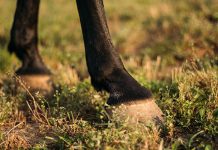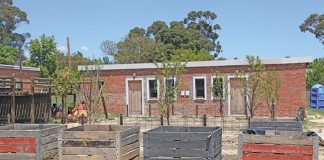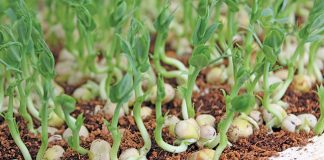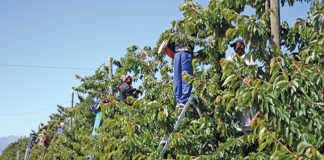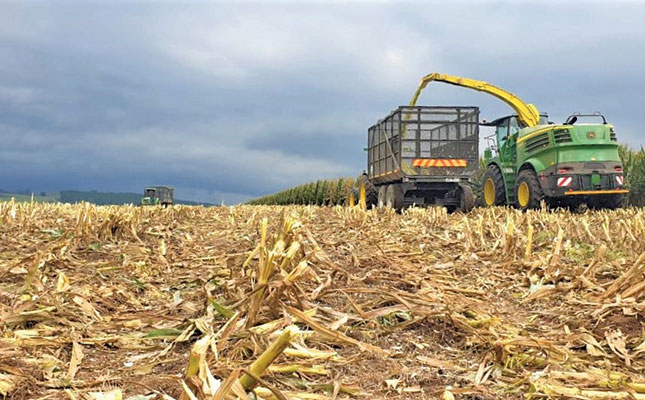
Photo: Johnston Contracting
The clean and neatly parked fleet of John Deere forage harvesters, tractors, and large haulage trailers on East End Farm make for an impressive sight.
Around mid-March, the collective roar of the powerful, green-and-yellow diesel machines reverberates across this farm in the Mooi River area of the KwaZulu-Natal (KZN) Midlands as they all head out to start their demanding task of bringing in local dairy farmers’ silage maize crops.
Not until as much as 2 000ha of silage maize crops, equating to approximately 130 000t of wet maize silage, have been harvested and safely ensiled in bunkers will the drivers of the fleet be able to enjoy a well-deserved rest.
Overseeing this hive of activity are Craig Johnston and his wife Kim, owners of Johnston Contracting, which provides silage harvesting and haymaking services to a number of dairy and other livestock farmers in the KZN Midlands.
At the time of writing, the Johnstons were preparing preliminary schedules for the farms where they will harvest silage. The schedules become more accurate and fixed the closer the time gets to the tight harvesting window of late February to mid-May.
“As recently as five or so years ago, the local effects of climate change were not as big a problem as they are now,” says Johnston. “At that time, weather patterns were still fairly predictable, and our silage maize-growing clients would all plant their crops from late October to early November with the aim of having these crops ready by mid-March for harvesting.
“Nowadays, our clients are having to wait longer for the warmer soil temperatures and consistent rainfall they need to start planting, and even these factors vary across the KZN Midlands.”
Johnston explains that local dairy farmers want their silage maize crops harvested when the plants are at optimal maturity, moisture content and nutritional value, and then quickly and properly ensiled in on-farm bunkers. This allows the silage an optimal period to ferment under anaerobic conditions before winter, when the farmers start feeding it to their animals.
As soon as their silage maize crops are harvested, farmers immediately use the opportunity to plant green feed crops, such as oats and stooling rye, in the same lands as added grazing for the cows during winter.
Ready to harvest
Johnston himself plants a total of 370ha to yellow maize on East End Farm and on other farms he leases. Some of this is harvested as silage, while the balance is harvested as grain. Both are sold directly to local livestock farmers and other buyers. Johnston’s choice of yellow maize hybrids is guided by seed agent Kevin Gotte.
Gotte explains that most Midlands dairy farmers plant short-season yellow maize hybrids that are ready for harvesting 120 to 130 days from planting, if all goes well.
“Their strategy is to grow hybrids that can achieve maximum yield and quality within a relatively short growing season, followed by [a period] to get their green feed crop seed into the soil,” he says.
Some dairy farmers plant silage maize into old pastures rich in free potassium, thanks to cattle dung and urine.
“This saves a lot of money on potassium fertiliser for the maize crops. Once the silage maize crops are harvested and the following green feed crops have been used, the dairy farmers usually plant the field back to pasture.”
Gotte adds that glyphosate-tolerant silage maize hybrids are popular among dairy farmers, as they make weed control relatively easy. Farmers don’t want competition from weeds that could result in both the roughage and grain from silage maize crops being negatively affected.
“The farmers start checking on their standing silage maize crops as soon as they notice the green leaves turn brown,” says Gotte. “This indicates that the plants are drying down.”
Farmers look at random cobs on the land to see if the maize kernels have reached maturity.
According to Johnston, immature yellow maize kernels are typically plump with moisture and ooze a white fluid when crushed. As a cob starts maturing, its kernels begin drying out, starting at the point where each kernel is attached to the cob. Over a period of weeks, the drying process moves throughout the kernels.
A kernel sufficiently mature and dry for harvesting as silage will show a white germ cell that extends about two-thirds of the interior length of the kernel. This is called the ‘milk line’.
The kernel’s surface farthest away from where it joins the cob will also show a concave dent. At this point, the plant’s moisture content is 30% to 35%. This is the optimal time for harvesting the standing crop as silage.
A higher plant moisture content results in fluids leaking out from the bunker where the harvested and chopped crop has been ensiled. Valuable nutrients are lost in this way.
“Harvesting excessively moist silage maize also reduces the power and fuel consumption efficiency of my silage harvesters and [other equipment used in the process]. Moreover, the higher load weights damage trailers and tractors,” says Johnston.
If having to harvest excessively moist silage is unavoidable for the Johnston Contracting
team, perhaps because a farmer cannot afford to leave the crop standing on the land any longer, Johnston can change settings in his forage harvesters to reduce liquid leakage from the plant material in the silage bunkers.
One setting increases the harvester’s chop length to between 17mm and 19mm, which enables the longer fibres in the chopped silage to better retain their moisture content. He can also adjust the machine’s kernel processor, which cracks each kernel open, to a width of between 2,5mm and 3mm; this helps prevent the wetter, softer kernels from being mashed, instead of split, by the kernel processor.
Dry silage
If excessively dry silage maize is harvested without the settings on the harvesters being adjusted, the chopped material will be difficult to compact properly in the silage bunker. This allows air into the bunker, causing the maize to rot rather than ferment.
“For excessively dry silage maize, I reduce the chop length to between 8mm and 10mm, and close the kernel processor down to 1,5mm,” says Johnston. “The finer chop length improves compaction of the plant material in the bunker, and the narrowed kernel processor cracks the hard and dry kernels effectively.”
According to Johnston, the ideal chop length for a silage maize crop with 30% to 35% moisture content is 14mm, and the optimal kernel processor setting is 2mm to 2,5mm.
Beneficial bacteria
Silage inoculant must be applied to the chopped material before it leaves the forage harvester.
Debbie Odell, co-owner of animal nutrition products retailer and consultancy Bovasol in Mooi River, says most silage inoculants are concentrated forms of lactic acid bacteria.
Added to chopped silage maize that is correctly ensiled, these bacteria facilitate the rapid drop in pH needed for effective fermentation of the silage, while preventing the proliferation of other bacteria species that would otherwise spoil the silage.
“Improved fermentation leads to decreased dry matter losses from, and improved retention of, plant protein in the silage,” explains Odell.
“The lactic acid bacteria ferment the plant sugars to lactic acid and, to some extent, acetic acid and other volatile fatty acids. Acetic acid helps contain the proliferation of yeasts and moulds at silage surfaces exposed to air at feed-out.”
Johnston says other factors affecting the speed of silage harvesting include rough,
steep or wet lands. On average, his forage harvesters travel at 6km/h to 8km/h while working in-field.
In addition to travelling slower if the standing crop’s moisture content is high, the machines require a slower forward speed to handle high-yielding silage maize crops effectively. The average yield of wet (fresh) maize silage in the KZN Midlands ranges from 35t/ha to 65t/ha.
Johnston says that the further away the silage maize land is from the bunker, the more tractor-trailer combinations are needed to ensure that a forage harvester does not stand idle until an empty tractor-trailer arrives.
Unlike combine harvesters, which have onboard storage, forage harvesters draw in, chop, crack, inoculate and disgorge silage maize crops in a single process.
Johnston adds that getting silage maize harvested, delivered to a bunker, compacted into the bunker and properly covered as fast as possible is essential to ensuring good-quality silage.
Keeping their equipment in peak operational condition is therefore a major focus of their management strategy. Any breakdown of a forage harvester halts the entire harvesting process.
“Our operation depends on keeping moving for it to stay profitable,” he says. “This is especially necessary given that the purchase prices of new forage harvesters and tractors increased by an average of 27% year-on-year between 2019 and 2020. And they’re likely to increase again this year.”
Email Craig Johnston at [email protected], Kevin Gotte at [email protected], or Debbie Odell at [email protected].






